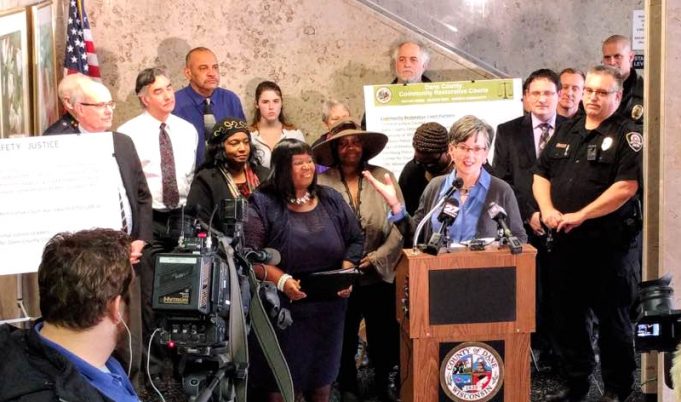“We have to ask the questions: How do we repair harm? How do we reduce recidivism? How do we give people another change in our community? That’s what this Community Restorative Court is all about,” says Dane County Supervisor Shelia Stubbs. “We’re looking at low-risk and low-level offenders ages 17-25. They’ve made mistakes. But we don’t think that mistakes that you’ve made when you are young should impact your future, your career, your whole life.”
Stubbs represents the district where the Community Restorative Court’s pilot program is located and she is very passionate about keeping young offenders out of the criminal justice system. She tells Madison365 that this program started two years ago as a pilot program for the city is really working.
“I think we’re officially out of the pilot stage. It has been going really well. It’s been going so well that we’ve been able to handle two major media cases that involved race,” says Stubbs of University of Wisconsin-Madison student Denzel McDonald, accused of spray painting political graffiti on campus property last spring, and Genele Laird, who was accused of threats and resisting arrest at East Towne Mall. “If we didn’t have community restorative courts as an asset in our community, I’m very uncertain where these two cases would have gone. I believe they would have probably gone through the traditional criminal justice system.”
Dane County’s community restorative courts are joining a national effort to improve the criminal justice system and they recently received a $50,000 donation from the John D. and Catherine T. MacArther Foundation that will provide an expansion to the county’s current program. Dane County is one of 20 counties and cities to receive grants to improve criminal justice reforms. Restorative justice is a community-based form of justice that seeks to repair the harm caused by crime.
“The Community Restorative Court is a great example of what can be accomplished when community partners work together,” says Dane County District Attorney Ismael Ozanne, in a statement.

The Community Restorative Court‘s mission is to “Repair Harm, Reduce Risk, and Rebuild the Community” using restorative justice principles to divert youth ages 17-25 from the traditional criminal justice system. One key outcome has been addressing racial disparities within the criminal justice system.
“We are very excited about this grant that will help us get the technical assistance that we need and it will open up other opportunities,” Stubbs says. “We are hoping to get even more money in the future and to be able to change the lives of more young people. We’re hoping to change pathways.”
Stubbs says that she thinks it’s important for the overall community to think about what has led to outrageous racial disparity and incarceration numbers in Dane County first highlighted by the Race to Equity report from a few years ago. “Those daunting disparities came because we were doing things traditionally and it was not working,” she says. “We needed to think about doing productive things and about alternatives and not being afraid to try something new. That’s what I’m really proud about. We weren’t afraid to try something new. The traditional system had made it worse … why not try something different?”
In 2017, Dane County’s funding for the Community Restorative Court went from $110,000 to $200,000. With the new MacArthur grant, it will now have $250,000 to work with.
The Community Restorative Court connects offenders with the victims of those crimes through trained volunteer “peacemakers,” who go through a 16-hour training on restorative justice and policing. It provides for them a way to accept responsibility and repair the harm they’ve done through community service or other means. Those who complete the program are not formally charged with a crime, and their names do not appear in court records. The Community Restorative Court prevents young people from being in the Court Automation Programs (CCAP).
“CCAP is so detrimental to a person. Once you’re in that system, it judges you from all kinds of components – when you go to get an apartment, when you go to get a job, etc. I’m happy that the Community Court eliminates the branding of people,” Stubbs says. “Once they successfully complete the course, they will not have a CCAP entry.”
The new grant funding will allow the program to expand throughout all of Dane County. Funding received will support the program in providing technical assistance in design and training and to implement local reforms.
“We have had all the players at the table to make this successful. The bottom line is that the community was saying that we have a problem in Madison, Wisconsin, so there wasn’t much pushback against this idea,” Stubbs says. “People maybe didn’t have a sense of how this would work, so I think that this was the hardest part of this process … learning the system and the technical support.”
Stubbs says that the court receives referrals from law enforcement and the district attorney’s office and that it reduces recidivism and builds communities using a restorative justice model. Participation in the program provides a young person who has committed a low-level offense the opportunity to work with community members to ensure accountability, determine restitution, and repair the harm done.
“The community has embraced this project and it can’t work without their support,” Stubbs says. “We are grateful for their support.”
Since it started, 63 people have successfully gone through the program.
“Our next step is hiring a full-time social worker for the Community Court in May,” Stubbs says. “Our goal is to keep increasing our staff and to expand throughout the County. We also have the Fitchburg Police Department on board with us … we’ve been meeting with them for 8 months. The Town of Madison is on board, Sun Prairie is being considered, Middleton, Stoughton, McFarland and eventually UW campus.
“I think this is huge when you are looking at law enforcement if we can expand over the entire county,” she adds.




























